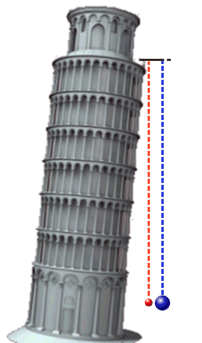| Return to First Quarter Page
Motion in One Dimension
| There are five variables that are involved in one-dimensional motion: displacement (Δx), time (Δt), initial velocity (vi), final velocity (vf), and acceleration (a). If you have any three of these values you can solve for a fourth.
|
| We are now going to derive the three equations that are used for one-dimensional motion. They each serve a purpose and we will start with the formula for acceleration. |
| aavg |
= |
vf - vi |
= |
vf - vi |
|
|
| tf - ti |
Δt |
| The first thing we need to do is multiply the Δt over to the other side to eliminate the fraction. The resulting equation is:
|
| We can then add the initial velocity, vi, to both sides to solve for the final velocity. The result is the VELOCITY WITH CONSTANT ACCELERATION expression or the "WITHOUT DISPLACEMENT" formula.
|
| To derive the second equation we will start with the displacement equation from the previous lesson.
|
| We will substitute the expression for final velocity above into the displacement equation to yield:
|
| Δx = ½(vi + aavgΔt + vi)Δt |
| Combining the vi terms and distributing the Δt you get:
|
| Distributing the ½ results in the DISPLACEMENT WITH CONSTANT ACCELERATION expression or the "WITHOUT FINAL VELOCITY" formula:
|
| To derive the third equation we will start with the displacement equation from the previous lesson.
|
| Multiply both sides by 2 to eliminate the ½.
|
| We will then divide both sides by vi + vf to isolate the Δt.
|
| This value for Δt is then substituted into the final velocity equation from above.
|
| The vi is subtracted to the other side.
|
| We will next multiply both sides by the denomenator vi + vf to yield:
|
| (vf + vi) (vf - vi) = 2aΔx |
| Completing the difference of two squares we get:
|
| Solving for vf2 results in the FINAL VELOCITY AFTER ANY DISPLACEMENT expression or the "WITHOUT TIME" formula:
|
| Let's try a couple of examples.
|
| Example: A plane starting at rest at one end of a runway undergoes a constant acceleration of 4.8 m/s2 for 15 s before takeoff. What is the speed of the plane at takeoff? |
|
Looking at the information that is given in the problem we can make a chart of givens.
- Δx = NA
- vi = 0 m/s
- vf = ?
- a = 4.8 m/s2
- Δt = 15 s
From the data we see that we do not have a Δx so we will use the WITHOUT DISPLACEMENT equation. |
| Δx = viΔt + ½aavgΔt2) |
| Δx = (0 m/s)(15 s) + ½(4.8 m/s2)(15 s)2) |
| Δx = 540 m |
| Let's try one more sample problem.
|
| Example: A women pushes a stroller starting from rest and accelerates at a rate of .500 m/s2. What is the velocity of the stroller after it has traveled 4.75 m? |
|
Looking at the information that is given in the problem we can make a chart of givens.
- Δx = 4.75 m
- vi = 0 m/s
- vf = ?
- a = .500 m/s2
- Δt = NA
From the data we see that we do not have a vf so we will use the WITHOUT FINAL VELOCITY equation. |
| vf2 = 2aΔx + vi2 |
| vf2 = 2(.500 m/s2)(4.75 m) + (0 m/s)2 |
| vf2 = 4.75 m2/s2 |
| vf = √(4.75 m2/s2) |
| vf = 2.18 m/s |
Gravity in One Dimension
 The first step is to realize that gravity is a form of acceleration. It was established by Galileo that all objects will fall at the same rate. This rate is gravitational acceleration, or g. The first step is to realize that gravity is a form of acceleration. It was established by Galileo that all objects will fall at the same rate. This rate is gravitational acceleration, or g.
The next step is to consider motion in the vertical direction. The equations are the same except for the replacement of Δy for Δx since we are moving vertically and we have a standard value for acceleration which is gravity, g. The value of -9.81 m/s2 is assigned to g. |
| Let's try a couple of examples.
|
| Example: A potted plant starting at rest on a window sill 35 m above the ground is knocked off. How long does it take the plant to hit the ground? |
|
Looking at the information that is given in the problem we can make a chart of givens.
- Δy = 35 m
- vi = 0 m/s
- vf = NA
- a = 9.81 m/s2
- Δt = ?
From the data we see that we do not have a vf so we will use the WITHOUT FINAL VELOCITY equation for gravity. |
| Δy = viΔt + ½gavgΔt2) |
| -35 m = (0 m/s)(Δt) + ½(-9.81 m/s2)(Δt)2) |
| -35 m = ½(-9.81 m/s)(Δt)2 |
| |
|
-35 m |
= Δt2 |
|
|
|
| ½(-9.81 m/s) |
| 7.14 s= Δt2 |
| 2.67 s= Δt |
| Let's try one more sample problem.
|
| Example: How fast will that same potted plant be moving just before it hits the ground? |
|
Looking at the information that is given in the problem we can make a chart of givens.
- Δy = -35 m
- vi = 0 m/s
- vf = ?
- a = -9.81 m/s2
- Δt = NA
From the data we see that we do not have a vf so we will use the WITHOUT FINAL VELOCITY equation. |
| vf2 = 2aΔy + vi2 |
| vf2 = 2(-9.81 m/s2)(-35 m) + (0 m/s)2 |
| vf2 = 686.7 m2/s2 |
| vf = √(686.7 m2/s2) |
| vf = 26.2 m/s |
Go To Next Lesson
Return to First Quarter Page
|


 The first step is to realize that gravity is a form of acceleration. It was established by Galileo that all objects will fall at the same rate. This rate is gravitational acceleration, or g.
The first step is to realize that gravity is a form of acceleration. It was established by Galileo that all objects will fall at the same rate. This rate is gravitational acceleration, or g.